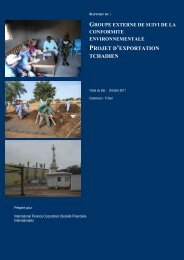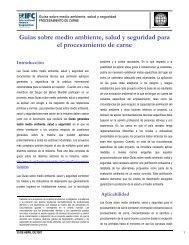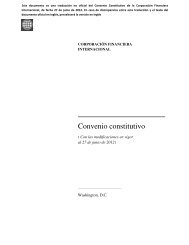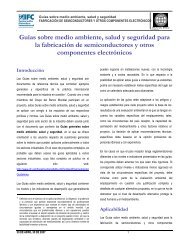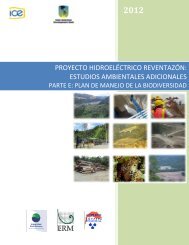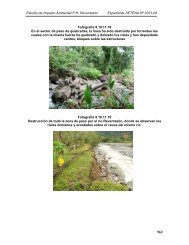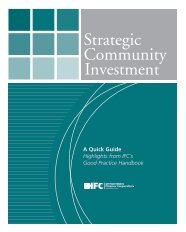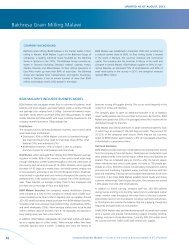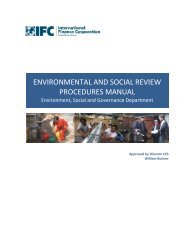Download PDF - IFC
Download PDF - IFC
Download PDF - IFC
You also want an ePaper? Increase the reach of your titles
YUMPU automatically turns print PDFs into web optimized ePapers that Google loves.
<strong>IFC</strong>’s Vision, Purpose, and Values<br />
Our vision is<br />
that people should have the opportunity to<br />
escape poverty and to improve their lives.<br />
Our values are<br />
• Excellence<br />
• Commitment<br />
• Integrity<br />
• Teamwork<br />
Our purpose is to<br />
• Promote open and competitive markets in<br />
developing countries<br />
• Support companies and other private<br />
sector partners<br />
• Generate productive jobs and deliver<br />
basic services<br />
• Create opportunity for people to escape<br />
poverty and improve their lives<br />
www.ifc.org<br />
Telling Our Story<br />
2008<br />
FRONTIER FOCUS<br />
<strong>IFC</strong> in the World’s Poorest Countries
What is IDA?<br />
Founded in 1960, the International Development<br />
Association is the World Bank window providing<br />
long-term loans and grants to the world’s 80 poorest<br />
countries, 39 of them in Africa. Since its inception, it has<br />
provided $182 billion for projects in health, education,<br />
infrastructure, financial services, and other critical sectors.<br />
Countries with per capita gross national incomes of $1,065<br />
or less are currently eligible to receive funds from IDA.<br />
<strong>IFC</strong>’s funding and operations directly support the goals of IDA,<br />
paving the way toward economic growth, job creation, higher<br />
incomes, and better living conditions for the poor. It comes as<br />
part of <strong>IFC</strong>’s broader focus on the frontier, including a substantial<br />
commitment in the poorest regions of middle-income<br />
countries as well.
Turning Needs into Opportunities<br />
Lorem ipsum dolor sit amet, consectetuer adipiscing<br />
elit, sed diam nonummy nibh euismod tincidunt ut<br />
laoreet dolore magna aliquam erat volutpat. Ut wisi<br />
enim ad minim veniam, quis nostrud exerci tation<br />
ullamcorper suscipit lobortis nisl ut aliquip ex ea commodo<br />
consequat.<br />
Duis autem vel eum iriure dolor in hendrerit in vulputate<br />
velit esse molestie consequat, vel illum dolore eu<br />
feugiat nulla facilisis at vero eros et accumsan et iusto<br />
odio dignissim qui blandit praesent luptatum zzril<br />
delenit augue duis dolore te feugait nulla facilisi. Lorem<br />
ipsum dolor sit amet, consectetuer adipiscing elit, sed<br />
diam nonummy nibh euismod tincidunt ut laoreet<br />
dolore magna aliquam erat volutpat. Ut wisi enim ad<br />
minim veniam, quis nostrud exerci tation ullamcorper<br />
suscipit lobortis nisl ut aliquip ex ea commodo consequat.<br />
Duis autem vel eum iriure dolor in hendrerit in<br />
vulputate velit esse molestie consequat.<br />
Vel illum dolore eu feugiat nulla facilisis at vero eros et<br />
accumsan et iusto odio dignissim qui blandit praesent<br />
luptatum zzril delenit augue duis dolore te feugait.<br />
Nam liber tempor cum soluta nobis eleifend option<br />
congue nihil imperdiet doming id quod mazim placerat<br />
facer possim assum. Lorem ipsum dolor sit amet,<br />
consectetuer adipiscing elit, sed diam nonummy nibh<br />
euismod tincidunt ut laoreet dolore magna aliquam erat<br />
volutpat. Ut wisi enim ad minim veniam, quis nostrud<br />
exerci tation ullamcorper suscipit lobortis nisl ut aliquip<br />
ex ea commodo consequat.<br />
Duis autem vel eum iriure dolor in hendrerit in vulputate<br />
velit esse molestie consequat, vel illum dolore eu<br />
feugiat nulla facilisis at vero eros et accumsan et iusto<br />
odio dignissim qui blandit praesent luptatum zzril<br />
delenit augue duis dolore te feugait nulla facilisi. Lorem<br />
ipsum dolor sit amet, consectetuer adipiscing elit, sed<br />
diam nonummy nibh euismod tincidunt ut laoreet<br />
dolore magna aliquam erat volutpat. Ut wisi enim ad<br />
minim veniam, quis nostrud exerci tation ullamcorper<br />
suscipit lobortis nisl ut aliquip ex ea commodo consequat.<br />
Duis autem vel eum iriure dolor in hendrerit in vulputate<br />
velit esse molestie consequat, vel illum dolore eu<br />
Cover Photo: In Bangladesh, <strong>IFC</strong> works closely with BRAC, a nongovernmental organization reaching some<br />
of the poorest women in the world.<br />
feugiat nulla facilisis at vero eros et accumsan et iusto<br />
odio dignissim qui blandit praesent luptatum zzril delenit<br />
augue duis dolore te feugait nulla facilisi.<br />
Nam liber tempor cum soluta nobis eleifend option<br />
congue nihil imperdiet doming id quod mazim placerat<br />
facer possim assum. Lorem ipsum dolor sit amet,<br />
consectetuer adipiscing elit, sed diam nonummy nibh<br />
euismod tincidunt ut laoreet dolore magna aliquam erat<br />
volutpat. Ut wisi enim ad minim veniam, quis nostrud<br />
exerci tation ullamcorper suscipit lobortis nisl ut aliquip<br />
ex ea commodo consequat.<br />
Lars Thunell<br />
Executive Vice President and CEO, <strong>IFC</strong><br />
<strong>IFC</strong> Activity in IDA Countries, Fiscal Year 2007<br />
• Investment commitments in IDA countries<br />
represented 44 percent of <strong>IFC</strong>’s total number<br />
of projects.<br />
• Some 62 percent of total <strong>IFC</strong> spending on<br />
advisory services projects was in IDA countries.<br />
• <strong>IFC</strong> investments in Africa increased from $140<br />
million in Fiscal Year 2003 to $1.4 billion in<br />
Fiscal Year 2007.<br />
Lars Thunell at Bujagali, Uganda<br />
1
Inclusive and Sustainable Globalization<br />
The World Bank Group’s Six Strategic Directions<br />
The vision of the World Bank Group is to contribute to an inclusive and sustainable<br />
globalization—to overcome poverty, enhance growth with care for the environment, and<br />
create individual opportunity and hope. <strong>IFC</strong> has a contribution to make on all six<br />
themes, each of which has an important private sector component.<br />
Poorest Countries<br />
Helping overcome poverty and spur sustainable<br />
growth in the poorest countries, especially in<br />
Africa.<br />
Fragility and Conflict<br />
Addressing the special challenges of states<br />
coming out of conflict or seeking to avoid the<br />
breakdown of the state.<br />
Middle-Income Countries<br />
Develop a competitive menu of development<br />
solutions for middle income countries, involving<br />
customized services as well as finance.<br />
Global Public Goods<br />
Playing a more active role with regional and<br />
global public goods on issues crossing national<br />
borders, including climate change, HIV/AIDS,<br />
malaria, and aid for trade.<br />
The Arab World<br />
Supporting those advancing development and<br />
opportunity in the Arab world.<br />
Knowledge and Learning<br />
Fostering a knowledge and learning agenda<br />
across the World Bank Group to support its role<br />
as a ‘brain trust’ of applied experience.<br />
Contents<br />
n HEALTH AND EDUCATION<br />
n An Affordable Alternative<br />
Building Private Health Care 4<br />
n Business Edge<br />
“We always had excellent products, but didn’t know how to market them<br />
effectively. Now we do.” 6<br />
n INFRASTRUCTURE<br />
n Private Power<br />
Public Gain 8<br />
n Tourism Turnaround<br />
Reviving an Airline 10<br />
n CONFLICT-AFFECTED COUNTRIES<br />
n Trade and Development<br />
The Critical Combination 12<br />
n Mediation, Not Litigation<br />
Saving Time and Money 14<br />
n ACCESS TO FINANCE<br />
n Microfinance<br />
Recipe for Progress 16<br />
n <strong>IFC</strong> and BRAC<br />
Partners in Development 18<br />
n A Cotton Economy<br />
Moves One Step Ahead 20<br />
n Small-Scale Home Loans<br />
Where Supply Meets Demand 22<br />
n CLIMATE CHANGE<br />
n Making a Difference<br />
With Carbon Credits 24<br />
n ACCESSING GLObAL MARkETS<br />
2 Vellum Sheet<br />
Africa<br />
Yemen<br />
Uganda<br />
Samoa<br />
Liberia<br />
bosnia and Herzegovina<br />
Azerbaijan<br />
bangladesh<br />
Tajikistan<br />
Pakistan<br />
Nigeria<br />
Cambodia<br />
Honduras and Nicaragua<br />
n Fair Labor, Industry Growth<br />
Lessons from Phnom Penh 26<br />
n Better Coffee, Bigger Incomes<br />
A Premium Blend 28
An Affordable Alternative<br />
Building Private Health Care<br />
Malaria kills up to 3 million people a<br />
year, mostly children in Africa.<br />
While there is still no vaccine,<br />
considerable progress in the fight against this<br />
deadly disease is coming from today’s increased<br />
use of medicine derived from a plant called<br />
artemisinin.<br />
<strong>IFC</strong> is helping an East African company,<br />
Botanical Extracts EPZ Limited (Kenya), play<br />
a bigger role in this crucial battle. Botanical<br />
Extracts sells the plant’s extract to pharmaceutical<br />
giant Novartis, which turns it into powerful<br />
antimalarial drugs it distributes at cost in more<br />
than 30 African countries, saving an estimated<br />
200,000 lives a year.<br />
Meanwhile in West Africa, more than 220,000<br />
people can now afford Nigeria’s best hospitals<br />
and clinics through health insurance from local<br />
company Hygeia. Our $3 million loan helped<br />
Hygeia fuel an expansion drive that will soon<br />
enable it to reach far more people and provide<br />
better, more affordable medical care in the<br />
region with the world’s lowest health standards.<br />
As Africa’s economies improve, the demand<br />
for high-quality health care will only increase<br />
4 HEALTH AND EDUCATION<br />
Africa<br />
further. The private sector has an essential role<br />
to play.<br />
This is why <strong>IFC</strong> has launched a new $1 billion<br />
African health care strategy, including an equity<br />
fund for small and medium enterprises and<br />
a debt component. The Business of Health in<br />
Africa: Partnering with the Private Sector to Improve<br />
People’s Lives — a new report cosponsored<br />
by <strong>IFC</strong> and the Bill & Melinda Gates Foundation<br />
— estimates Africa will need investments<br />
of $25–30 billion in health care over the next<br />
decade.<br />
<strong>IFC</strong> and its partners will mobilize<br />
up to $1 billion in investment<br />
and advisory services over the<br />
next five years to support private<br />
health care in Africa.<br />
<strong>IFC</strong> helps make private health care more widely available — and affordable — in Africa.<br />
5
Business Edge<br />
Khadija Al-Basrawi, an energetic, university-educated<br />
woman in her mid-20s<br />
living in Yemen’s capital of Sana’a, had<br />
always dreamed of running her own business.<br />
Two years ago she did it—renting a few rooms in<br />
an apartment building, hiring a small staff, and<br />
putting them to work making sheets, clothes, and<br />
curtains.<br />
Then she discovered something. She knew how<br />
to make appealing products but not how to sell<br />
them.<br />
Through <strong>IFC</strong>’s Business Edge management training<br />
program, she found the affordable business guidance<br />
she needed. Khadija saw an ad and soon<br />
Khadija Al-Basrawi, Yemeni entrepreneur (left), reviewing<br />
a Business Edge workbook with a colleague.<br />
6 HEALTH AND EDUCATION<br />
Yemen<br />
”We always had excellent products, but didn’t know<br />
how to market them effectively. Now we do.”<br />
became one of more than 5,600 Yemeni business<br />
owners and workers who have learned how to<br />
manage and grow their enterprises with Business<br />
Edge. She has taken nine $35-a-day workshops<br />
delivered in Arabic by experienced, <strong>IFC</strong>-accredited,<br />
local instructors.<br />
Khadija learned how to target the right markets,<br />
call on clients, and close the deal. Now she sells<br />
steadily to six different wholesalers. From a halting<br />
beginning, her annual net income has risen dramatically<br />
from $300 to $3,600 and is growing.<br />
Business Edge builds a wide range of practical<br />
education and training skills, from accounting and<br />
personnel management to sales and marketing.<br />
Local training firms pay <strong>IFC</strong> $4,000 a year for<br />
rigorous, continually updated instruction materials<br />
and the right to offer Business Edge in their<br />
areas. They are closely monitored to ensure that<br />
they meet the program’s high quality standards. All<br />
trainers must be independently certified and have<br />
at least five years of management experience themselves.<br />
Developed in Asia and the Middle East, the<br />
program is now expanding, helping create opportunity<br />
in Haiti, Chad, and other countries.<br />
Business Edge management training workshop in Yemen, the Middle East’s poorest country. More than 100,000<br />
people have taken the training worldwide.<br />
7
Private Power<br />
Public Gain<br />
8 INFRASTRUCTURE<br />
Only 5 percent of Uganda’s people<br />
have access to electricity today, a rate<br />
that is far below the Sub-Saharan<br />
African average, and one of the world’s lowest.<br />
The small national grid is severely strained, and<br />
even those fortunate enough to be connected<br />
suffer frequent power outages.<br />
In Kampala, coffee shop owners complain<br />
that when the lights go out, customers walk<br />
out. The impact is even more measurable at a<br />
nearby furniture maker: workers must be paid<br />
even when machines are idle.<br />
All this will change with the opening of the<br />
Bujagali Hydropower Project in 2011, adding<br />
250 megawatts of clean power from a new dam<br />
being built on the Victoria Nile. It will almost<br />
double the Ugandan system’s capacity, ending<br />
the blackouts that have long deterred investors<br />
and damaged the economy.<br />
At $870 million, Bujagali is both the largest<br />
private infrastructure investment to date in<br />
East Africa and Uganda’s lowest-cost option for<br />
supplying additional electricity. It is a major<br />
step forward in the government’s power sector<br />
reform program, centered on the efficiencies<br />
Uganda<br />
that come with private ownership.<br />
<strong>IFC</strong> lent the Bujagali Energy Ltd. joint venture<br />
$130 million as part of a larger World Bank<br />
Group financing package. A related IDA partial<br />
risk guarantee of up to $115 million supports<br />
the project’s commercial lenders, Absa Capital<br />
of South Africa and Standard Chartered Bank<br />
of the U.K. An investment guarantee of up to<br />
$115 million from the Multilateral Investment<br />
Guarantee Agency provides equity risk insurance<br />
for U.S.-based Sithe Global Power, one of<br />
the project’s shareholders.<br />
<strong>IFC</strong> will prepare additional<br />
bankable infrastructure projects<br />
for future financing through<br />
InfraVentures, a new fund that<br />
will invest $100 million over five<br />
years in IDA countries.<br />
The plans: Bujagali is both the largest private investment to date in East Africa and Uganda’s lowest-cost option<br />
for supplying additional reliable electricity.<br />
9
Private Power<br />
Public Gain<br />
8 INFRASTRUCTURE<br />
Only 5 percent of Uganda’s people<br />
have access to electricity today, a rate<br />
that is far below the Sub-Saharan<br />
African average, and one of the world’s lowest.<br />
The small national grid is severely strained, and<br />
even those fortunate enough to be connected<br />
suffer frequent power outages.<br />
In Kampala, coffee shop owners complain<br />
that when the lights go out, customers walk<br />
out. The impact is even more measurable at a<br />
nearby furniture maker: workers must be paid<br />
even when machines are idle.<br />
All this will change with the opening of the<br />
Bujagali Hydropower Project in 2011, adding<br />
250 megawatts of clean power from a new dam<br />
being built on the Victoria Nile. It will almost<br />
double the Ugandan system’s capacity, ending<br />
the blackouts that have long deterred investors<br />
and damaged the economy.<br />
At $870 million, Bujagali is both the largest<br />
private infrastructure investment to date in<br />
East Africa and Uganda’s lowest-cost option for<br />
supplying additional electricity. It is a major<br />
step forward in the government’s power sector<br />
reform program, centered on the efficiencies<br />
Uganda<br />
that come with private ownership.<br />
<strong>IFC</strong> lent the Bujagali Energy Ltd. joint venture<br />
$130 million as part of a larger World Bank<br />
Group financing package. A related IDA partial<br />
risk guarantee of up to $115 million supports<br />
the project’s commercial lenders, Absa Capital<br />
of South Africa and Standard Chartered Bank<br />
of the U.K. An investment guarantee of up to<br />
$115 million from the Multilateral Investment<br />
Guarantee Agency provides equity risk insurance<br />
for U.S.-based Sithe Global Power, one of<br />
the project’s shareholders.<br />
<strong>IFC</strong> will prepare additional<br />
bankable infrastructure projects<br />
for future financing through<br />
InfraVentures, a new fund that<br />
will invest $100 million over five<br />
years in IDA countries.<br />
An architect’s simulation of the Bujagali dam, an upcoming private sector solution to Uganda’s energy woes.<br />
9
Tourism Turnaround<br />
Upolu island, Samoa.<br />
10 INFRASTRUCTURE<br />
Reviving an Airline<br />
<strong>IFC</strong>’s advisory services were crucial in helping<br />
the Samoan government inject new life<br />
into its national airline and spark a badly<br />
needed tourism boom.<br />
Tourism is not only the main magnet for foreign<br />
exchange on the tiny Pacific island republic,<br />
but also a critical source of jobs and hope<br />
for its people. But as recently as three years ago<br />
the international side of Samoa’s main air link,<br />
government-owned Polynesian Airlines, was<br />
barely surviving.<br />
<strong>IFC</strong> partnered with the government in 2005 to<br />
design a fair and transparent bidding process for<br />
investors willing to manage and invest in and<br />
revive the airline’s overseas routes. Frequently in<br />
infrastructure privatization deals, poor-country<br />
governments lack the experience needed to design<br />
Samoa<br />
the bidding procedures and contracts that will<br />
bring the best results for themselves and their people.<br />
But in this case, the <strong>IFC</strong>-led process attracted<br />
Virgin Blue, the Australian arm of billionaire Sir<br />
Richard Branson’s Virgin Group empire, a global<br />
leader in low-cost, high-service air travel.<br />
The Virgin unit entered into a joint venture with<br />
the government to run the airline, renamed it<br />
Polynesian Blue, cut fares by 35 percent, and<br />
promptly increased the number of people arriving<br />
from Samoa’s two key tourism markets, Australia<br />
and New Zealand, by 40 percent. PolyBlue is now<br />
profitable, island tourism revenue is up more than<br />
17 percent and the Samoan government is no longer<br />
pouring money into a money-losing business.<br />
The many Samoans working in New Zealand also<br />
have a far more affordable way to come home.<br />
PolyBlue won the Asia-Pacific airline industry’s<br />
award as “Best New Low-Cost Airline” in its<br />
first year.<br />
<strong>IFC</strong>’s advisory services generate<br />
$900 million a year in new private<br />
investment in infrastructure.<br />
Tourism revenues are up more than 17 percent in Samoa since <strong>IFC</strong> helped the government and private investors<br />
launch a new international airline, Polynesian Blue.<br />
11
Trade and Development<br />
The Critical Combination<br />
Few private businesses survived Liberia’s<br />
long and tragic civil war.<br />
One that did is Morris American Rubber<br />
Company (MARCO). It plays an important<br />
role in Liberia—a very poor country that<br />
is starting to bounce back after years of exclusion<br />
from the global economy.<br />
A supplier to international tire manufacturers,<br />
MARCO employs 400 workers. Most are<br />
former soldiers rebuilding their lives.<br />
Liberian President Ellen Johnson Sirleaf called<br />
the firm “a story of entrepreneurial success”<br />
when she visited it in January. She was there<br />
to see the new $2.5 million rubber processing<br />
plant the company has built in rural Montserrado<br />
County. A high point of Liberia’s new<br />
economy, it uses rubber processing machinery<br />
imported from Malaysia through <strong>IFC</strong>’s Global<br />
Trade Finance Program.<br />
The Malaysian institution at the other end of<br />
the $385,000 transaction had never heard of<br />
MARCO or its bank, the Liberian Bank for<br />
Development and Investment. But it had heard<br />
of <strong>IFC</strong> and felt confident it would receive payment<br />
because of our guarantee. The confidence<br />
12 CONFLICT-AFFECTED COUNTRIES<br />
Liberia<br />
allowed the equipment to be shipped, helping<br />
create a factory where MARCO’s workers will<br />
soon produce tire-grade rubber—and its chief<br />
executive is starting to think big.<br />
“It is now about time that we Liberians move<br />
to the next step to produce all levels of tires<br />
for export,” MARCO General Manager Keith<br />
Jubah says. “That is the only way we will build<br />
our economy.”<br />
The guarantee is part of a global $1 billion <strong>IFC</strong><br />
program that covers primarily small business<br />
transactions of less than $1 million. These<br />
guarantees help banks in Sub-Saharan Africa<br />
and other regions support increased trade flows<br />
in their countries.<br />
The program is one way that <strong>IFC</strong> helps<br />
conflict-affected countries like Liberia rebuild<br />
the private sector—their key drivers of job<br />
creation, economic growth, and stability.<br />
<strong>IFC</strong> is active in 40 conflict-affected<br />
countries and regions worldwide.<br />
<strong>IFC</strong>’s $1 billion Global Trade Finance Program helps Liberia rebuild its economy.<br />
13
Mediation, Not Litigation<br />
Saving Time and Money<br />
In Bosnia and Herzegovina, businesses that<br />
dare to use the bogged-down, backlogged<br />
court system to resolve disputes spend a<br />
year and a half on average in litigation. Even<br />
if they win, legal costs can devour nearly half<br />
the award—$40,000 on a $100,000 contract<br />
settlement, in one actual case.<br />
<strong>IFC</strong> has brought an inexpensive, fast, and<br />
efficient alternative to the country’s main<br />
commercial centers, Sarajevo and Banja Luka:<br />
mediation. These successful pilot projects are<br />
now slated to be rolled out nationally.<br />
For approximately $400, disagreeing parties<br />
can now hire a neutral, third-party mediator<br />
who helps them resolve their disputes. With<br />
both sides on equal footing at the table, rather<br />
than on opposite rows in a courtroom, the<br />
outcome is usually more satisfying to each.<br />
Result: 350 cases settled in three years, freeing<br />
more than $13.5 million in blocked assets that<br />
local businesses are now re-investing. Nearly 80<br />
percent of the firms that used this mediation<br />
have now reestablished commercial relationships<br />
with each other.<br />
14 CONFLICT-AFFECTED COUNTRIES<br />
bosnia and Herzegovina<br />
“Mediation has radically shortened the procedure<br />
and saved us a lot of money,” says Miroslav<br />
Jaslar, a small business manager from Sarajevo<br />
who resolved a three-year dispute in just two<br />
hours.<br />
Supported by the Canadian and Dutch governments,<br />
<strong>IFC</strong> helped introduce mediation in<br />
2004. It then worked to develop a professional<br />
association of mediators, using well-established,<br />
successful programs from North America and<br />
the European Union as models. Mediation has<br />
been embraced by Bosnia’s business and judicial<br />
communities, with two mediation centers now<br />
self-sustaining through user fees. <strong>IFC</strong> is taking<br />
this effective model to Pakistan and other<br />
IDA countries.<br />
“Commercial mediation was relatively<br />
unknown in Bosnia before <strong>IFC</strong>’s initiative,”<br />
says Judge Fatima Mrdovic. “It helps companies<br />
focus more on their business and spend<br />
less time in the courts, and it also reduces the<br />
backlog of cases we face in our courts.”<br />
Mediation improves the performance of Bosnian companies.<br />
15
Microfinance<br />
Recipe for Progress<br />
The Aliyev family owns a small farm<br />
near Sheki, Azerbaijan, in the foothills<br />
of the Caucasus mountains. They<br />
make the most of it, earning extra income from<br />
vegetable preserves and jam made from their<br />
favorite recipes.<br />
But before they can sell, they must spend—<br />
investing upfront in costly ingredients and materials,<br />
typically at times of the year when sales<br />
are slow. The resulting cash flow problems have<br />
long hurt the family business. For years even a<br />
small amount of financing would have helped,<br />
but it was almost impossible to find.<br />
Last year, eldest son Goshgar Aliyev walked<br />
into the Sheki branch of our client, the Microfinance<br />
Bank of Azerbaijan, and made his case.<br />
The bank saw his growth potential and extended<br />
a $1,400 loan—money he invested in new<br />
jars, sugar, and vinegar. Like most of the bank’s<br />
clients, the Aliyevs’ business had never before<br />
received a loan. But it is booming today, selling<br />
pickled gherkins and walnut jam in the tea<br />
houses and restaurants of Sheki. That first loan<br />
is now fully repaid, replaced by a larger one.<br />
As both an equity investor and an advisor,<br />
16 ACCESS TO FINANCE<br />
Azerbaijan<br />
<strong>IFC</strong> helped the lead sponsor, LFS Financial<br />
Systems of Germany, launch the microfinance<br />
bank in 2002. Demand was high from day<br />
one. But with no local bond or interbank loan<br />
markets to rely on, it needed outside capital to<br />
grow, and no mainstream investors would take<br />
the chance. <strong>IFC</strong>’s Global Microfinance Facility<br />
took the first step, providing a $750,000<br />
commercial loan in 2005. This encouraged<br />
Deutsche Bank, Dexia, and others to follow<br />
suit, and today the bank is one of Azerbaijan’s<br />
10 largest, reporting sixfold growth in the past<br />
two years.<br />
Making financial markets work for everyone is<br />
core business for <strong>IFC</strong>. Microfinance still serves<br />
less than 20 percent of its potential global market<br />
today. We help it attract one of the most<br />
essential ingredients for growth: private capital.<br />
<strong>IFC</strong> has directly financed more than<br />
50 microfinance institutions worldwide.<br />
They lend more than $8 billion<br />
a year to local entrepreneurs.<br />
Goshgar Aliyev (right) and his father, Famil, putting microfinance to good use in Azerbaijan.<br />
17
<strong>IFC</strong> and BRAC<br />
Partners in Development<br />
<strong>IFC</strong> works with clients of many kinds.<br />
One of them is Bangladesh’s BRAC, one<br />
of the world’s leading nongovernmental<br />
organizations (NGOs) and our close partner<br />
for more than a decade.<br />
Founded in 1972 by a visionary Shell Oil Co.<br />
executive, Fazle Hasan Abed, BRAC (formerly<br />
the Bangladesh Rural Advancement Committee)<br />
operates large-scale health, education, human<br />
rights, and microfinance programs while also<br />
owning several strong businesses whose profits<br />
reduce its need for donor funding. Today it<br />
reaches 110 million people in all parts of Bangladesh,<br />
spanning the income spectrum from<br />
ultra-poor to middle class. Small and donordependent<br />
upon creation, it now has a $400<br />
million annual budget, 80 percent of which<br />
comes from its own resources, and is expanding<br />
in Asia and Africa while keeping its core focus<br />
on Bangladesh.<br />
This year our partial guarantee allowed BRAC<br />
to borrow $18 million more in local currency<br />
from Citibank than it could have done on its<br />
18 ACCESS TO FINANCE<br />
bangladesh<br />
own. This new commercial financing will allow<br />
it to make more than 500,000 new microloans,<br />
primarily to poor rural women.<br />
We began working together in 1997, jointly<br />
supporting the launch of Bangladesh’s first<br />
stand-alone home loan institution. Delta<br />
BRAC Housing Finance Corporation is profitable<br />
today, helping thousands of families buy<br />
their own homes in one of the world’s poorest<br />
countries.<br />
The next project was BRAC Bank in 2004,<br />
a start-up targeting Bangladesh’s then largely<br />
untapped small and medium enterprise market.<br />
<strong>IFC</strong>’s investment and ongoing advice in IT<br />
systems, marketing, and new product development<br />
have helped the bank more than double<br />
its loan portfolio in the past two years. It now<br />
lends to more than 100,000 local entrepreneurs<br />
who would otherwise fall between the cracks<br />
of microfinance and mainstream commercial<br />
banking: the engineering firms, computer<br />
companies, and clothing stores that anchor<br />
the country’s emerging middle class. It is the<br />
fastest-growing bank in Bangladesh.<br />
Bangladesh’s BRAC: A major force for change.<br />
19
A Cotton Economy<br />
Moves One Step Ahead<br />
There is no doubt about it—$16,500<br />
goes a long way in rural Tajikistan, the<br />
poorest country in the former Soviet<br />
Union.<br />
Just ask the 44 farmers who own the MMM<br />
cooperative farm near the Afghan border. They<br />
borrowed that amount last summer from <strong>IFC</strong>’s<br />
local client, Tojiksoderot Bank (TSB).<br />
The money finances their entire planting<br />
cycle—covering all the costs of winter plowing,<br />
spring planting, and fall harvests. And it<br />
helps them escape a root cause of rural poverty<br />
in Tajikistan: exploitation by ruthless informal<br />
moneylenders in areas that big banks don’t<br />
reach. These entrenched local investors sell the<br />
farmers overpriced seed and other supplies early<br />
on, only to buy their cotton later at the lowest<br />
possible price, and are often accused of taking<br />
more than they pay for.<br />
TSB’s loans could make a big difference. Cotton-dependent<br />
Tajikistan has seen more than<br />
a million of its men—almost a third of the<br />
working population—move to Russia, hoping<br />
to earn money to send back to their families.<br />
20 ACCESS TO FINANCE<br />
Tajikistan<br />
TSB is one of the country’s top banks, mainly<br />
serving larger businesses. With our support, it<br />
now also lends directly to small and midsize<br />
co-op farms like MMM. A new Canadianfunded<br />
<strong>IFC</strong> program is helping it build this<br />
new business, generating approximately $1.3<br />
million in new loans to smaller cotton farms in<br />
the program’s first year.<br />
These loans come through a fairer and more<br />
transparent process, with more honest interest<br />
rates and reliable disbursement schedules, than<br />
what was previously available. For many, TSB’s<br />
loans are their first from a bank—an important<br />
step forward in rural Tajikistan.<br />
A newly expanded regional office<br />
in Almaty, kazakhstan.<br />
New loans from an <strong>IFC</strong> client bank make life better for Tajikistan’s cotton farmers.<br />
21
Small-Scale Home Loans<br />
Where Supply Meets Demand<br />
Three years ago, Zaigham Rizvi was at the<br />
peak of his development banking career,<br />
managing an investment company and<br />
living a comfortable life. Then he got a call.<br />
Pakistan’s government asked him to do something<br />
else. It wanted him to revive its nearly<br />
bankrupt House Building Finance Corporation<br />
(HBFC), the only institution catering to the<br />
housing finance needs of Pakistan’s sizeable lowincome<br />
population.<br />
He took on the challenge, launching a “Reform,<br />
Recovery, and Rehabilitation” program for the<br />
troubled state-owned institution. He sought—<br />
and received—<strong>IFC</strong>’s advisory services, and the<br />
turnaround began.<br />
In the first phase, <strong>IFC</strong> recommended key<br />
changes that HBFC then made, including<br />
strengthening critical functions such as accounting,<br />
information technology, and servicing loans.<br />
Phase two focused on nonperforming loans,<br />
which comprised a staggering 80 percent of<br />
HBFC’s total portfolio. The final phase focused<br />
on its mission of providing housing finance<br />
solutions to almost half of Pakistan’s population<br />
of 165 million—people who could qualify for<br />
22 ACCESS TO FINANCE<br />
Pakistan<br />
HBFC’s small loans, despite their low incomes.<br />
“These people work hard and are credit-worthy,<br />
yet they cannot obtain housing finance from<br />
banks,” Zaigham says, “because banks prefer to<br />
serve the rich.”<br />
Today HBFC is profitable. It is present in over<br />
100 Pakistani cities, nearly double the number<br />
of just two years ago. Nonperforming loans<br />
have decreased by 50 percent and capital has<br />
increased by 17.5 times. Its financial statements,<br />
which carried an audit qualification due to having<br />
unreconciled accounts since 1982, are finally<br />
clean.<br />
HBFC now has 150,000 clients and is helping<br />
an additional 7,500 poor families a year to<br />
build or improve homes, typically with $5,000,<br />
20-year mortgages. <strong>IFC</strong> has completed the first<br />
phase of its in-depth support package, and is<br />
considering a substantial investment to help<br />
attract other investors in HBFC’s proposed<br />
privatization.<br />
<strong>IFC</strong> has invested more than $2.8 billion in<br />
housing finance this decade.<br />
“Like all fathers, my wish was to provide permanent shelter for my kids. I approached everyone, but only HBFC<br />
would help.” —Illayas Mughal, electrician, Lahore<br />
23
Making a Difference<br />
With Carbon Credits<br />
24 CLIMATE CHANGE<br />
The private sector is expected to provide<br />
80 percent of all financing needed to<br />
combat climate change. In the poorest<br />
countries, it has a strong partner in <strong>IFC</strong>.<br />
We can help in many ways, including increasing<br />
the commercial use of both cleaner energy<br />
sources like natural gas and renewable sources<br />
such as wind, solar, hydro, and biomass. Nigeria,<br />
a country that could become one of the<br />
world’s largest sources of natural gas, provides<br />
an example of what we can do.<br />
Natural gas can be used to fire large-scale power<br />
plants producing far fewer global-warming<br />
emissions than other kinds of thermal plants.<br />
But due to a weak domestic market and lack of<br />
important gas-gathering infrastructure, Nigeria<br />
instead burns off large quantities of its natural<br />
gas associated with oil production, spewing<br />
round-the-clock flames and fumes that contribute<br />
to climate change.<br />
<strong>IFC</strong> has helped find a solution by participating<br />
in the Global Gas Flaring Reduction (GGFR)<br />
partnership alongside the World Bank, governments,<br />
and major oil companies. GGFR<br />
works with both the private and public sectors<br />
to increase the use of associated gas. Instead of<br />
Nigeria<br />
wasting the gas, Nigeria now uses some of it to<br />
fuel a power plant in the troubled Niger Delta<br />
where local communities urgently need reliable<br />
electricity.<br />
In late 2006, GGFR provided carbon finance<br />
advice and other technical support that helped<br />
a proposed 450 MW gas-fired power plant at<br />
Kwale earn important carbon credits under the<br />
Kyoto Protocol. This was key to making this<br />
project commercially viable.<br />
In this context, Italian oil company Eni, a partner<br />
in the gas flaring initiative, invested more<br />
than $400 million to build the plant. It was the<br />
Kyoto treaty’s first Nigerian project, and one of<br />
its largest anywhere in the world. The impact<br />
of the carbon dioxide emissions from gas flaring<br />
it avoids over 10 years is equal to taking 2.7<br />
million cars off U.S. roads.<br />
The Kwale plant spells progress in the Delta.<br />
And its success in obtaining carbon credits<br />
could have an important replication effect in<br />
other countries around the world.<br />
Climate action is a core development<br />
priority for <strong>IFC</strong>.<br />
Satellite image of West Africa’s rampant burning of natural gas—a key source of air pollution today, but also<br />
one that can be converted to generate environmentally friendly power.<br />
25
Fair Labor, Industry Growth<br />
Lessons from Phnom Penh<br />
Fair labor practices are like many other<br />
aspects of sustainable business—instead<br />
of dragging down profits, they can drive<br />
competitive advantage.<br />
This has certainly been the case in Cambodia,<br />
where the garment sector has built a global<br />
reputation for high labor standards. Its equitable<br />
pay and good working conditions now<br />
attract many of clothing’s largest, most imageconscious<br />
brands. Abhorring the thought of<br />
being associated with sweatshops, these buyers<br />
have helped make apparel Cambodia’s top<br />
industry, generating $2.6 billion in annual<br />
exports despite earlier concerns that it would be<br />
decimated by higher labor costs.<br />
26 ACCESSING GLObAL MARkETS<br />
Cambodia<br />
Since 2005, <strong>IFC</strong> has partnered with the Inter-<br />
national Labour Organization to support this<br />
process by helping build a buyers’ forum that<br />
brings together Gap, Nike, Levi Strauss, and<br />
other socially responsible firms. It is part of a<br />
broader ILO project that has brought verified<br />
improvements in working conditions in Cambodia,<br />
promoting the business case for such<br />
standards by working closely with manufacturers,<br />
unions, government, NGOs, and donor<br />
agencies.<br />
A decade ago, before these changes were introduced,<br />
the industry had just 80,000 workers in<br />
Cambodia. Today it employs nearly 350,000.<br />
Most are poorer women from the villages like<br />
Son Sean, 20, who makes shirts at a Marks and<br />
Spencer supplier in Phnom Penh. She has built a<br />
new house for her mother and kept her younger<br />
sister in school with her earnings. She also gets<br />
overtime pay, sick leave, and other benefits.<br />
<strong>IFC</strong> and the ILO are now adapting key parts of<br />
Cambodia’s experience to other countries and<br />
industries through Better Work, a new initiative<br />
that seeks to increase competitiveness by<br />
improving labor standards. Combining independent<br />
assessments of working conditions,<br />
enterprise-level training, and creation of new<br />
buyers’ forums, Better Work is starting with<br />
programs in Jordan, Lesotho, and Vietnam that<br />
will benefit nearly 800,000 workers.<br />
Improved working conditions are the cornerstone of Cambodia’s largest industry, apparel. Its successes have<br />
inspired a new global <strong>IFC</strong>/ILO program, Better Work.<br />
27
Better Coffee, Bigger Incomes<br />
A Premium Blend<br />
Thousands of small-scale coffee farmers<br />
in Central America’s poorest countries<br />
are making more money through sustainable<br />
agricultural practices developed with<br />
<strong>IFC</strong>’s financing and business advice. They are<br />
increasing the quality of their coffee, improving<br />
their growing methods, and satisfying a<br />
demanding buyer: Nestlé, the world’s largest<br />
food and beverage company.<br />
The farmers must first get independent approvals<br />
from several sources, including global<br />
commodities firm ECOM and Nestlé’s certification<br />
partner the Rainforest Alliance, a<br />
respected NGO focused on sustainable agriculture.<br />
When they do, the farmers benefit<br />
not only from efficiency gains that help them<br />
command a higher price, but also through the<br />
likelihood of a long-term business relationship<br />
with Nestlé.<br />
This project taps into <strong>IFC</strong>’s market-building<br />
expertise, linking producers, roasters, exporters,<br />
and consumers. It benefits all sides by helping<br />
develop a higher-quality, more socially and<br />
environmentally friendly product.<br />
28 ACCESSING GLObAL MARkETS<br />
Honduras and Nicaragua<br />
<strong>IFC</strong> offers both financial support and highquality<br />
advisory services. The financial support<br />
comes through a $25 million loan to ECOM<br />
that is channeled into microcredit for the coffee<br />
producers. The advisory services, which could<br />
raise farmers’ yields and productivity up to 40<br />
percent, takes the form of <strong>IFC</strong>/Nestlé–funded<br />
training helping farmers in Honduras and<br />
Nicaragua plant new hybrid varieties that can<br />
distinguish their coffee in a crowded marketplace<br />
and improve their growing and harvesting<br />
methods. The end result: increased productivity,<br />
leading to more money for the farmers and<br />
more jobs for the workers they hire.<br />
The project addresses one of the key Millennium<br />
Development Goals—cutting poverty<br />
and hunger in half by 2015. This can be done,<br />
the World Bank’s 2007 World Development<br />
Report says, only by harnessing the power of<br />
agriculture. Today’s global economy presents<br />
exceptional opportunities to do so through<br />
investments in agriculture as new markets for<br />
high-value products expand rapidly, the report<br />
explains.<br />
<strong>IFC</strong> helps Nicaraguan coffee farmers grow more productive.<br />
29
How <strong>IFC</strong> Measures Performance<br />
<strong>IFC</strong> has a long-term commitment to measuring results.<br />
In an external benchmarking study (2005), <strong>IFC</strong>’s evaluation system and framework for investments—based on an<br />
evaluation of a random, representative sample of projects using a standard framework and independent validation—was<br />
judged to be the most consistent with good practice standards for private sector investments agreed among multilateral<br />
development banks.<br />
To enhance our measurement of the development effectiveness of our investment and advisory work, <strong>IFC</strong> introduced in<br />
2005 the Development Outcome Tracking System (DOTS), which enables ongoing tracking following <strong>IFC</strong>’s established<br />
standards. A 2007 comparison of development results measurement in private-sector oriented international financial<br />
institutions showed <strong>IFC</strong> again to be at the forefront in development results measurement, particular through reporting<br />
on the current development results of our entire portfolio, by using an external assurance provider to validate the<br />
methodology and data accuracy, and by innovating through control group experiments for advisory services.<br />
In applying DOTS to <strong>IFC</strong> investments, we distinguish four areas of performance:<br />
• For financial success, which measures return to the financiers, we compare returns to our client companies’ cost<br />
of capital.<br />
• For economic returns, which measure returns to society as a whole, we compare benefits against a benchmark of 10<br />
percent annually, plus inflation.<br />
• To assess social and environmental performance, we look at compliance with <strong>IFC</strong>’s performance standards.<br />
• To assess private sector development impacts, we look at how investments contribute to private sector development<br />
beyond the client company.<br />
We use an aggregate index, based on these four components, to measure overall development outcome.<br />
Our tools to measure the development outcomes and impacts of advisory work range from cost-benefit analyses to inform<br />
decision making at the outset, to before-and-after analyses, to randomized experiments with large-scale data collection<br />
efforts. <strong>IFC</strong> leads in developing the use of such experiments for advisory work in emerging markets.<br />
In DOTS for advisory services, we look at five dimensions of advisory project performance, which are synthesized into an<br />
overall rating of development effectiveness:<br />
• Immediate deliverables, or outputs.<br />
• Medium-term outcomes, measured in terms of changes in knowledge, behavior, or performance.<br />
• Longer-term impacts, such as higher productivity, higher income, and growth.<br />
• Strategic relevance and the fit of the advisory service engagement to the issues at hand.<br />
• The efficiency of the engagement: project costs in relation to potential results.<br />
HOW TO CONTACT US<br />
<strong>IFC</strong> has offices in more than 80 countries around the world.<br />
Please contact the nearest regional office for further information.<br />
Headquarters<br />
Washington, D.C.:<br />
<strong>IFC</strong> Corporate Relations<br />
2121 Pennsylvania Ave., N.W.<br />
Washington, D.C., 20433 USA<br />
Telephone: (1-202) 473-3800<br />
Western Europe<br />
Paris:<br />
66, Ave. d’Iéna<br />
75116 Paris, France<br />
Telephone: (33-1) 4069-3060<br />
London:<br />
12th Floor, Millbank Tower<br />
21-24 Millbank<br />
London SW1P 4QP, United Kingdom<br />
Telephone: (44-207) 592-8400<br />
Brussels: (World Bank Office)<br />
10 Rue Montoyer<br />
B-1000 Brussels, Belgium<br />
Telephone: (32-2) 522-0034<br />
Frankfurt:<br />
Bockenheimer Landstrasse 109<br />
60325 Frankfurt, Germany<br />
Telephone: (49-69) 743-48230<br />
Central and Eastern Europe<br />
Moscow:<br />
36, Bldg. 1, Bolshaya Molchanovka Street<br />
3rd Floor<br />
Moscow 121069, Russian Federation<br />
Telephone: (7-495) 411-7555<br />
Design: Corporate Visions, Inc.<br />
Printing: ?<br />
Southern Europe and Central Asia<br />
Istanbul:<br />
Buyukdere Cad. No: 185, Kanyon Ofis Blogu<br />
Kat 10<br />
Levent 34394<br />
Istanbul, Turkey<br />
Telephone: (90-212) 385-3000<br />
East Asia and the Pacific<br />
Hong Kong:<br />
14/F, One Pacific Place<br />
88 Queensway Road<br />
Hong Kong<br />
Telephone: (85-2) 2509-8100<br />
Beijing:<br />
15th Floor, China World Tower 2<br />
China World Trade Center<br />
No. 1Jian Guo Men Wai Avenue<br />
Beijing, China 100004<br />
Telephone: (86-10) 5860-3000<br />
Tokyo:<br />
Fukoku Seimei Building 10F<br />
2-2-2, Uchisaiwaicho, Chiyoda-ku 100<br />
Tokyo, Japan<br />
Telephone: (81-3) 3597-6657<br />
South Asia<br />
New Delhi:<br />
50-M, Shanti Path, Gate No. 3<br />
Niti Marg, Chanakyapuri 110 021<br />
New Delhi, India<br />
Telephone: (91-11) 4111-1000<br />
Middle East and North Africa<br />
Cairo:<br />
Nile City Towers, 2005 Corniche el Nil<br />
North Tower<br />
24th Floor, Boulac<br />
Cairo, Egypt<br />
Telephone: (20-2) 461-9161/65<br />
Sub-Saharan Africa<br />
Johannesburg:<br />
14 Fricker Road, Illovo, 2196<br />
Johannesburg, South Africa<br />
Telephone: (27-11) 731-3000<br />
Nairobi:<br />
Hill Park Building<br />
Upper Hill Road<br />
Nairobi, Kenya<br />
Telephone: (254-20) 322-6340/400<br />
Latin America and the Caribbean<br />
São Paulo:<br />
Edifico Torre Sul, Rua James Joule<br />
65-190 andar<br />
Cidade Mongoes<br />
São Paulo, SP, Brazil<br />
Telephone: (55-11) 04576-080<br />
Mexico City:<br />
Montes Urales, Oficina 503<br />
Colonia Lomas de Chapultepec<br />
Delegacion Miguel Hidalgo<br />
Mexico, D.F., 1100 Mexico<br />
Telephone: (52-55) 4111-10003098-0130


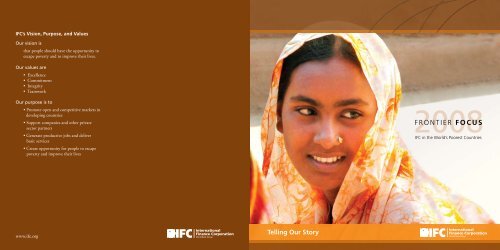
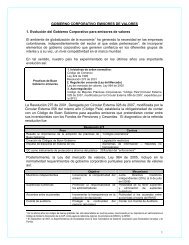
![Business Membership Organizations [pdf] - IFC](https://img.yumpu.com/15413100/1/190x245/business-membership-organizations-pdf-ifc.jpg?quality=85)
